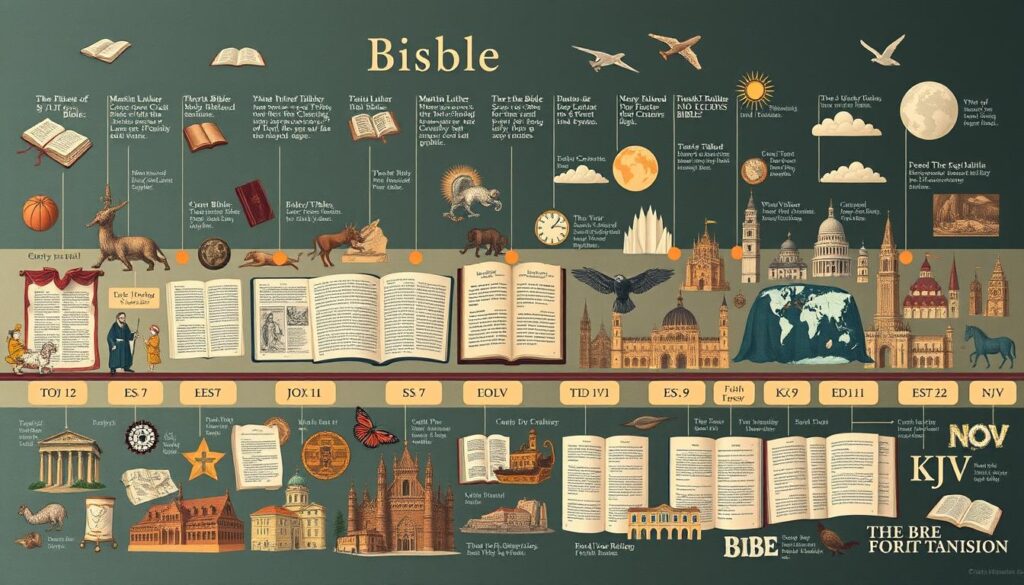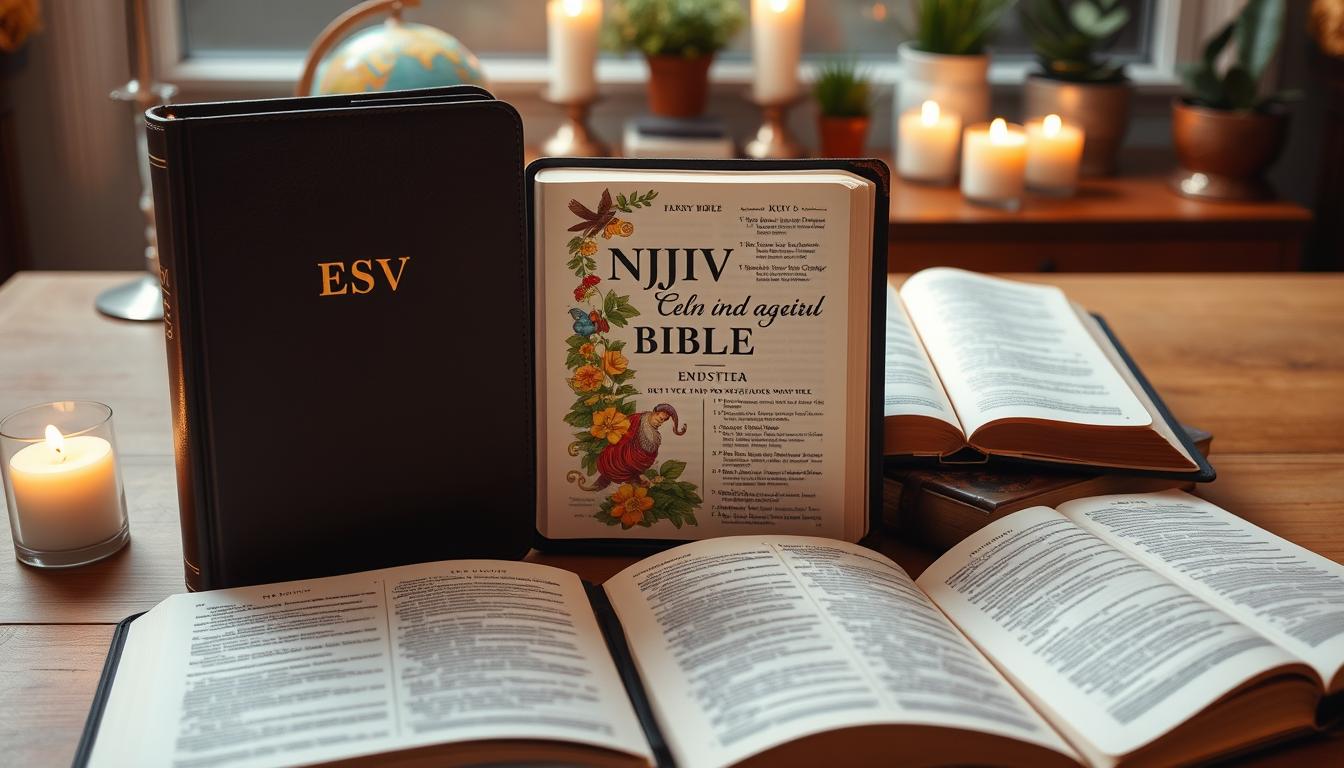Which Bible translation is right for you? Should you choose the English Standard Version (ESV), the New International Version (NIV), or the classic King James Version (KJV)? Each has its own fans, but how do they stack up in terms of accuracy, ease to read, and staying true to the original texts?
This article explores the main differences between the ESV, NIV, and KJV. It helps you pick the best Bible translation for your study needs and personal taste. The KJV and NIV are among the most popular translations in English. The KJV sticks to a word-for-word approach, while the NIV goes for a thought-for-thought style. As you learn about these translations, you’ll understand what makes them unique and the ongoing debate about their use.

Transform Your Faith Journey: Explore Our Engaging Bible Study eBooks
Key Takeaways
- The ESV, NIV, and KJV are three of the most prominent Bible translations in English, each with its own strengths and weaknesses.
- The KJV is renowned for its formal, word-for-word approach, while the NIV favors a more dynamic, thought-for-thought translation.
- Translations can vary significantly in their treatment of certain biblical terms and phrases, with the data showing diverse wording across versions.
- Personal preference and intended use play a significant role in determining the most suitable Bible translation for an individual.
- Understanding the historical context, translation philosophies, and target audiences of these versions can help readers make an informed decision.
Introduction to Bible Translations
Bible translations are key to sharing God’s Word with people everywhere in their own languages. Today, over 450 English Bibles are out, from old Middle English to modern versions. They help connect the original languages of the Bible (Hebrew, Aramaic, and Greek) to today’s readers.
The Importance of Bible Translations
Translations open up the Bible to more people and help them understand it better. By June 2013, the top five Bibles were the NIV, KJV, ESV, NLT, and NKJV. This variety meets different readers’ needs, spreading the Bible’s message far and wide.
Historical Background of Bible Translations
The journey of Bible translations began in the Middle Ages with the Latin Vulgate in the 4th century. The KJV, finished in 1611, was a big step, made by 47 scholars for King James I. Since then, many English Bibles have been made, each offering a fresh view of the Bible.

“The importance of Bible translations lies in the fact that they bridge the gap between the original biblical languages (Hebrew, Aramaic, and Greek) and the languages spoken by modern readers.”
| Translation | Characteristics | Reading Difficulty |
|---|---|---|
| New International Version (NIV) | Dynamic translation, aiming for balance between accuracy and readability | 7.80 |
| King James Version (KJV) | Literal (word-for-word) translation, based on late Byzantine text-type and Textus Receptus manuscripts | N/A |
| English Standard Version (ESV) | Literal translation, prioritizing accuracy of text over readability | N/A |
In summary, Bible translations have been vital in sharing the Bible with people all over. From the Latin Vulgate to today’s English Bibles, each version has helped connect the Bible’s original languages to today’s readers. This has deepened our understanding and appreciation of God’s Word.
Understanding the ESV (English Standard Version)
The English Standard Version (ESV) is a modern Bible translation. It aims for word-for-word accuracy while being easy to read. This version follows a formal equivalence approach, trying to keep the original language and word choice as close as possible. It’s becoming more popular, especially in some Protestant churches.
Overview of the ESV Translation
The ESV was first published in 2001 and updated in 2016. It’s known for its commitment to staying true to the original texts. The ESV is seen as more readable than the King James Version (KJV) for English speakers. Its name, “English Standard Version,” shows its goal of being inclusive worldwide.
Goals and Approach of the ESV
The ESV team focuses on formal equivalence, aiming to keep the original language and word choice. This method ensures the translation stays faithful to the biblical sources while being understandable to today’s readers. The ESV aims to provide a reliable and accurate translation for deep Bible study.

“The ESV is a translation that is true to the original languages, allowing the reader to study the Bible in a way that is faithful to the inspired Word of God.”
| Translation | Publication Date | Translation Approach | Popularity |
|---|---|---|---|
| English Standard Version (ESV) | 2001 (updated 2016) | Formal Equivalence | Gaining popularity among Protestants |
| Good News Translation (GNT) | 1976 (revised 1992) | Meaning-Based | Widely used in youth Bible study groups |
| King James Version (KJV) | 1611 | Word-for-Word | Most widely owned and used in the US |
| New International Version (NIV) | 1978 (revised 1984, 2011) | Blend of Form-Based and Meaning-Based | Popular among traditional and conservative denominations |
| New Living Translation (NLT) | Revision of 1971 Living Bible | Meaning-Based | Suited for youth and adults with difficulty in traditional language |
| Revised Standard Version (RSV) | 1977 | Combination of Formal Equivalence and Functional Equivalence | Widely used in mainline Protestant churches |
The NIV (New International Version)
The New International Version (NIV) is a widely used Bible translation worldwide. It was first published in 1978 after a decade of work by scholars and linguists. The NIV aims to balance literal translation and dynamic equivalence. It makes the Bible easy to read and understand for today’s readers while staying true to the original text.
History and Development of the NIV
The NIV started in the late 1960s with a goal to make the Bible more readable. A team of over 100 scholars from different denominations worked together. They aimed to keep the NIV close to the original texts but in a more natural English style.
Today, the NIV is one of the most popular Bible translations, with millions sold worldwide. It’s especially loved in the Evangelical Christian community for its clear and easy-to-understand language. The NIV’s approach has helped reach new people with the Bible’s message.
| Translation | Description |
|---|---|
| New International Version (NIV) | A balance between literal translation and dynamic equivalence, prioritizing readability and accessibility for modern readers. |
| King James Version (KJV) | Considered unsuitable for contemporary English due to its 17th-century language. |
| New American Standard Bible (NASB) | Less readable than the NIV but more literal in translation. |
| English Standard Version (ESV) | Strikes a better balance between literalness and readability compared to the NIV and NASB. |
The NIV has made the Bible more accessible and understandable for today’s readers. Its impact in the Evangelical community has helped bring millions to faith in Christ over the last four decades.

ESV vs NIV vs KJV: Bible Translation Comparison
The English Standard Version (ESV), New International Version (NIV), and King James Version (KJV) are top choices for Bible readers. Each has its own way of translating the Bible, with strengths and weaknesses. Knowing these differences helps deepen our understanding of the Scriptures.
The ESV sticks to a literal translation, aiming for accuracy. The NIV focuses on the overall meaning of the text. The KJV uses older language, which can be hard for today’s readers.
The ESV is easier to read than the KJV, with an 8th-grade level. The NIV is even simpler, at a 7th-grade level. This makes the NIV more accessible to many readers.
These versions also vary in their sources. The ESV and NIV use many ancient texts. The KJV relies mainly on 16th-century Greek texts. This choice affects the accuracy of the translations, especially in disputed passages.
Choosing a Bible translation is a personal decision. It depends on your beliefs, language skills, and preferences. By understanding the differences, you can pick the best version for your spiritual journey.
Comparing Translation Philosophies
Bible translations fall into two main types: literal (or formal equivalence) and dynamic (or functional equivalence). Literal translations keep the exact wording and order of the original languages. On the other hand, dynamic equivalence translations aim to share the meaning and intent in everyday language. This difference is key to grasping the unique qualities of different Bible versions.
Literal vs. Dynamic Equivalence
Literal translations, like the English Standard Version (ESV) and the New American Standard Bible (NASB), closely follow the original Greek and Hebrew. This method ensures accuracy but can make the English harder to read. Dynamic translations, such as the New International Version (NIV), aim to share the message in clear, natural English, even if it means changing some words.
Formal vs. Functional Equivalence
The formal equivalence method, seen in the ESV and NASB, seeks a word-for-word translation. This approach keeps the original language’s structure but might make the English less smooth. The functional equivalence method, as in the NIV, focuses on conveying the overall message in a way that’s easy to understand, even if it means some changes from the original words.
Knowing about these translation philosophies helps you understand the strengths and weaknesses of different Bible versions. It also helps you pick the one that fits your needs and preferences best.

| Translation Philosophy | Approach | Examples |
|---|---|---|
| Literal (Formal Equivalence) | Closely matches the original language structure and syntax | ESV, NASB |
| Dynamic (Functional Equivalence) | Focuses on conveying the overall meaning and intent in natural language | NIV |
Accuracy and Readability
Finding the right mix between accuracy and easy-to-read translations is tricky. Literal translations like the New American Standard Bible (NASB) and the New King James Version (NKJV) aim to keep the original words. But, they might not be as easy to understand. On the flip side, translations like the New Living Translation (NLT) and the Contemporary English Version (CEV) aim to be clear and natural. They might lose some of the original’s fine details.
Different translations show their unique ways of tackling tough passages. For example, how to translate “rakhum” in Psalm 79:8 varies. Some use “mercy,” “compassion,” “pity,” or “help” to get the point across. Also, figuring out King Saul’s age and reign in 1 Samuel 13:1 shows the hard work in understanding ancient texts. The word “paidagogos” in Galatians 3:24 is another example of the fine details translators must handle.

In the end, Bible translations need to find a balance between being true to the original and easy to read. The ESV, NIV, and KJV each try to meet different readers’ needs in their own way.
Language Style and Idioms
The way a Bible is translated affects how easy it is to read. Translators face the challenge of keeping the original meaning and cultural context. They also need to make sure the text speaks to today’s readers.
The King James Version (KJV) is known for its formal and majestic language. This can be hard for today’s readers to understand because of its old words. The New International Version (NIV) and the New Living Translation (NLT) are clearer and easier to read. This makes them more accessible to many people. The English Standard Version (ESV) tries to find a middle ground. It updates the KJV’s language but keeps some formality.
Dealing with biblical idioms is also key in Bible translation. Idioms are phrases that can’t be translated word for word. Literal translations like the New American Standard Bible (NASB) aim to keep the original words. Meanwhile, translations like the NIV and Contemporary English Version (CEV) focus on the meaning in today’s language.
Use of Modern Language
The choice of language in a Bible translation affects how well it connects with today’s readers. Translations like the NLT and CEV use modern words and phrases. This makes them appealing to those who want a more relatable reading experience. On the other hand, translations like the KJV and NASB are preferred by those who value the original text’s historical and linguistic integrity.
Choosing the right Bible translation depends on personal preference, reading level, and purpose. Knowing the language style and approach of different translations helps readers make a choice. This choice can enhance their connection with the Bible.
Target Audience and Reading Level
Choosing the right Bible translation is key. It matters who you are and how you read. Different versions help students and scholars understand the Bible in their own way.
The King James Version (KJV) is popular in many places. Yet, it might be hard for some to read. The English Standard Version (ESV) is easier to understand. It’s great for kids and adults alike.
How easy a Bible is to read depends on its words and structure. The ESV tries to be both accurate and easy to read. This makes it good for many people. The New International Version (NIV) uses everyday language. This makes it more relatable to today’s readers.
Choosing a Bible version should match your needs. If you’re studying, a specific version might help. Or, if you’re part of a group, pick one that fits your community’s style.
“The KJV Bible version was first published in 1611, and errors were printed in subsequent editions, such as the exclusion of the word ‘not’ from the verse ‘thou shalt not commit adultery’ in the 1631 edition, leading to it being known as the Wicked Bible.”
Exploring Bible translations can be complex. The ESV, NIV, and KJV each serve different purposes. Think about what you need and choose wisely.
Textual Basis and Source Manuscripts
The foundation of a Bible translation is key to its accuracy and trustworthiness. The English Standard Version (ESV), New International Version (NIV), and King James Version (KJV) use different ancient texts and critical editions.
The ESV sticks to a literal translation, using the Masoretic Text for the Old Testament and the Nestle-Aland/United Bible Societies’ Greek text for the New Testament. The NIV balances between literal and dynamic translation, using a wide range of texts, including the Dead Sea Scrolls. The KJV, known for its old-fashioned language, relies on the Textus Receptus for its New Testament.
Ancient Manuscripts Used
Each translation has its own set of ancient texts and critical editions. The ESV and NIV use the Dead Sea Scrolls, offering insights into the biblical text’s evolution. The KJV, however, leans on the Textus Receptus, the main Greek text from its time.
The NIV team, with over 100 scholars, ensures a thorough review of its sources. The ESV and KJV, with smaller teams, are still widely accepted and read.
The choice of texts and manuscripts greatly affects a Bible translation’s accuracy, clarity, and theological depth. Knowing the roots of these translations helps readers pick the best version for them.
Biblical Accuracy and Theological Bias
Bible translations are complex and balance accuracy with interpretation. The teams’ theological views can greatly affect the text’s wording and meaning. This section looks at how the English Standard Version (ESV), New International Version (NIV), and King James Version (KJV) teams try to stay neutral. It also explores how their beliefs might influence the translations.
The American Standard Version (1901) leans towards Formal Equivalency (FE), while the New Living Translation and Message Bible are at the Dynamic Equivalency (DE) end. The KJV, New King James, and ESV are closer to FE, while the NIV and New Revised Version are closer to DE. The NIV’s translation of Galatians 5 has been criticized for using “sinful nature” instead of “flesh” for “sarx.” The ESV has also faced questions over its translation of Romans 10:10, with some seeing it as promoting a specific doctrine of salvation.
The ESV gained popularity after a well-known gospel preacher, Wayne Jackson, praised it. Yet, it has faced criticism for its theological bias, making some doubt its use for deep Bible study. It’s important to remember that each English Bible translation has its own flaws and issues, like how they handle “baptizo” and “porneia.”.
The real challenge is not finding the perfect Bible version. It’s about using different translations to fully understand the Scriptures. As one scholar noted, “The issue is not the accuracy of any particular translation, but the need to use multiple translations to arrive at the true meaning of the text.”
| Bible Translation | Copyright Date | Translation Philosophy |
|---|---|---|
| New International Version (NIV) | 1973, 1978, 1984, 2011 | Dynamic Equivalency |
| Holman Christian Standard Bible (HCSB) | 1999 to 2009 | Formal Equivalence |
| English Standard Version (ESV) | 2001 | Formal Equivalence |
| New King James Version (NKJV) | 1982 | Formal Equivalence |
| New American Standard Bible (NASB) | 1960 to 1995 | Formal Equivalence |
The ESV is the go-to Bible for many evangelical Reformed Christians. The NKJV is known for its accuracy and clear language, with a higher reading level than most books. The NASB is seen as the most accurate English Bible translation, ideal for those seeking literal translations.
In the United States, 88% of people own at least one Bible, with an average of 4.4 Bibles per household. However, only 43% of Americans read the Bible at least five times a year. It’s crucial to evaluate each Bible version’s accuracy and potential biases to gain a full understanding of the biblical text.
Copyright and Usage Considerations
Using Bible translations in publications requires careful attention to copyright and usage permissions. In the United States, a work is protected by copyright as soon as it’s created and fixed in a tangible form. This means that many Bibles, like the New International Version (NIV) and the English Standard Version (ESV), need permission to quote their text.
But, some Bibles are in the public domain. This allows their use without restrictions or needing permission. The King James Version (KJV) and The World English Version (WEB) are examples of these public domain Bibles. They can be freely quoted and used in various publications.
For copyrighted Bibles, publishers have specific guidelines. They dictate how many verses or what percentage of text can be quoted without permission.
Copyright Restrictions and Permissions
It’s crucial to know the copyright rules and permissions for each Bible translation when publishing. For example, the NIV text can be quoted up to 500 verses without permission, as long as it’s not a complete book or more than 25% of the total text. The English Standard Version (ESV) also has lenient copyright terms, allowing quotes in non-saleable media without a complete copyright notice, but requiring “ESV” at the end.
Copyright usually expires 50 to 100 years after the author dies, depending on the country. In the United States, works published before 1923 are public domain. This includes older Bibles like the King James Version and Revised Standard Version.
When using Bible passages, make sure to format and cite them correctly. Use the correct book name abbreviation followed by chapter and verse numbers. This ensures proper attribution and helps readers find the referenced verses.
Understanding copyright and usage guidelines for Bible translations is key for authors, bloggers, and content creators. By knowing these rules, they can use biblical passages legally and ethically in their work.
Popularity and Acceptance
The popularity of Bible translations depends on many things. These include how well-known a translation is, the preferences of different churches, how easy it is to read, and how accurate it is. The New International Version (NIV) is the top choice for many in the Evangelical Church. On the other hand, the King James Version (KJV) is seen as too old-fashioned for today’s English.
The English Standard Version (ESV) is known for being clear and faithful to the original text. It’s easier to read than the New American Standard Bible (NASB) but stays true to the original words.
The ESV keeps the spirit of the KJV alive but is easier for today’s readers to understand. The NIV has helped bring millions to faith in Christ over the years. This shows its big impact and wide appeal. The ESV, following the KJV’s path, offers a mix of being literal and easy to read.
The English Standard Version (ESV) was first released in 2001 and updated in 2016. It follows a method that aims for accuracy. The King James Version (KJV), from 1611, is still the most common Bible in the U.S. It’s valued for its long history and classic feel. The New International Version (NIV), first out in 1978 and updated in 1984 and 2011, is loved by many. It’s especially popular in traditional and conservative churches.
There are many Bible translations out there, like the NIV, NKJV, and ESV. The Bible was written in Hebrew, Aramaic, and Greek. It’s been translated into many versions to reach more people. Different translations are good for different things, like daily reading, studying, or sharing verses.
Some translations include extra books not found in the original Bible. For example, the CEB, CEV, ESV, GNT, KJV, NABRE, NJB, NRSV, REB, and RSV all have these books. It’s wise for new Christians to avoid paraphrased Bibles like The Passion Translation (TPT) or The Message (MSG). These versions might not be as clear or deep as traditional ones.
Looking at different Bible translations can give you new insights. It helps you find the one that speaks to you the most. When picking a Bible, think about why you need it, how much you want to understand, and what you like. Advice varies for beginners and those more familiar with their faith.
“The popularity and acceptance of a Bible translation can be influenced by a variety of factors, including brand recognition, denominational preferences, readability, and perceived accuracy.”
Strengths and Weaknesses of Each Translation
Each Bible translation has its own strengths and weaknesses. The English Standard Version (ESV) is easy to read at a 7th-grade level. It keeps many old theological terms but can feel outdated in some parts. It’s not the best for public readings.
The New International Version (NIV) is loved for being modern and easy to understand. But, it sometimes lost accuracy for better readability.
The King James Version (KJV) is known for its beautiful language. Yet, its old-fashioned words can be hard to grasp. The New King James Version (NKJV) keeps much of the KJV’s charm but loses some accuracy.
The Holman Christian Standard Bible (HCSB) aims for clear and literal translation. It also has lots of footnotes for better understanding. In contrast, the New American Standard Bible (NASB) is very literal but can feel stiff in English.
Choosing a Bible translation depends on what you value most. Some prefer accuracy and authenticity, while others like easy-to-read versions. There’s no single “right” translation. It’s best to listen to the Holy Spirit to find the right Bible for you.
Choosing the Right Translation for You
Choosing a Bible translation is a personal choice. It depends on your needs, preferences, and study goals. You should think about accuracy, readability, language style, who it’s for, and any theological bias.
If you want a translation that’s very accurate, the English Standard Version (ESV) is good. It’s easy to read, like a 10th grade school level. On the other hand, if you like translations that focus on meaning, the New Living Translation (NLT) is great. It’s easy to read, like a 6th grade level.
If you’re looking for something in between, the Christian Standard Bible (CSB) might be right for you. The choice should match your study style and needs. This could be for deep study, group talks, or teaching new believers about the Bible.
| Translation | Translation Philosophy | Recommended Use |
|---|---|---|
| ESV | Word-for-Word | In-depth study and personal development |
| NLT | Thought-for-Thought | New believers, group studies, or first-time Bible readers |
| CSB | Middle-ground | General use |
Remember, picking a Bible translation is very personal. Think about what you need and prefer to find the right one for you. The most important thing is to keep reading and engaging with God’s Word, no matter the translation.
Conclusion
This detailed comparison of the ESV, NIV, and KJV Bible translations has given readers a better grasp of each version’s strengths and weaknesses. We looked at their translation philosophies, accuracy, and how easy they are to read. This helps readers choose the Bible version that fits their needs and preferences.
The article stressed the need to consider different views when picking a Bible translation. This way, readers can pick a version that will help them understand and connect with the Bible better.
The conclusion of Bible translation comparison, summary of key insights, and final thoughts on choosing a Bible version are all part of this conclusion. Now, readers can choose the Bible version that suits them best. They will understand the differences and what to consider when making their choice.
This article has been a great help for those looking to find the right Bible translation. It offers valuable insights to make a choice that will enhance their spiritual journey. By using these insights, readers can confidently pick a Bible version that will strengthen their connection with God’s Word.
FAQ
What are the key differences between the ESV, NIV, and KJV Bible translations?
The ESV, NIV, and KJV Bible translations differ in their approach. The ESV aims for a literal translation. The NIV balances literal and dynamic translation. The KJV is an older, formal translation.
Why are Bible translations important, and how have they developed over time?
Bible translations make the Word of God accessible in our native languages. They bridge the gap between ancient languages and modern ones. From the Latin Vulgate to today’s English translations, they’ve made the Bible more accessible.
What are the key features and goals of the English Standard Version (ESV) Bible translation?
The ESV is a modern, literal translation. It aims for word-for-word accuracy while being easy to read. The team focuses on preserving the original language and structure.
How was the New International Version (NIV) developed, and what are its key characteristics?
The NIV was first published in 1978 after a decade of work by scholars and linguists. It balances literal and dynamic translation. It aims to be readable and accurate for modern readers.
What are the main differences in translation philosophy between literal (formal equivalence) and dynamic (functional equivalence) Bible translations?
Literal translations aim to keep the original wording. Dynamic translations focus on conveying the meaning in natural language. Knowing these philosophies helps understand the strengths and limitations of different translations.
How do the ESV, NIV, and KJV handle the balance between accuracy and readability?
Literal translations like the ESV prioritize original language. Dynamic translations like the NIV focus on natural language. Finding a balance is key to making the Bible accessible and faithful to the original.
How do the ESV, NIV, and KJV differ in their use of modern language and handling of biblical idioms?
The language style and idioms in a translation affect its readability. The ESV, NIV, and KJV use different approaches to convey meaning and cultural context for today’s readers.
Who are the target audiences and intended reading levels for the ESV, NIV, and KJV Bible translations?
Bible translations are tailored for specific audiences and reading levels. The ESV, NIV, and KJV suit different readers, from students to scholars. Factors like vocabulary and sentence structure play a role.
What are the textual bases and source manuscripts used in the ESV, NIV, and KJV translations?
The textual basis and source manuscripts affect a translation’s accuracy. The ESV, NIV, and KJV use different ancient manuscripts and editions. This can impact the text’s integrity.
How do the ESV, NIV, and KJV handle the issue of theological bias in their translations?
Bible translations can reflect the translators’ theological views. The ESV, NIV, and KJV teams aim for objectivity. However, their doctrinal leanings may influence the final wording.
What are the copyright and usage considerations for the ESV, NIV, and KJV Bible translations?
Copyright and usage permissions are crucial for authors and bloggers. The ESV, NIV, and KJV have different restrictions. These should be considered when using these translations in various contexts.
How do the ESV, NIV, and KJV Bible translations compare in terms of popularity and acceptance within the Christian community?
Popularity and acceptance depend on factors like brand recognition and readability. The ESV, NIV, and KJV have varying levels of popularity. Some translations are more widely accepted than others.

